In 7OMM with Doug Louden, Part 2 |
Read more at in70mm.com The 70mm Newsletter |
| Written by: Doug Louden, Sydney, Australia | Date: 05.01.2021 |
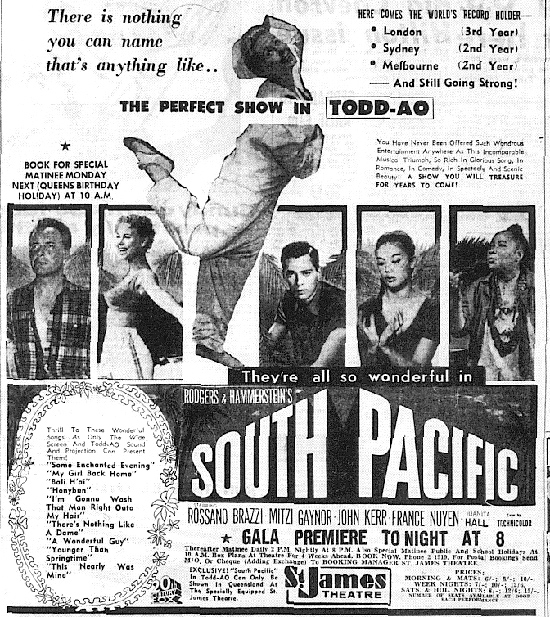 Pls
note: Due to Covid and subsequent restrictions with our research,
some of the storyboards are still missing dates which fellow researcher,
Greg Beasley, and myself will endeavour to complete this year 2021! Pls
note: Due to Covid and subsequent restrictions with our research,
some of the storyboards are still missing dates which fellow researcher,
Greg Beasley, and myself will endeavour to complete this year 2021!There were forty [40] key city theatres which opened the initial seasons of 70mm film titles in Australia and another seventeen [17] cinemas which were also equipped for 70mm. I have started collating the film titles released for each these fifty seven [57] cinemas. Here it is our intention to post all 57 cinemas by Christmas this year [2020]. There will also be storyboards created in 2020 for the 70mm film titles released between 1958 to 1974. If readers finds a discrepancy on a storyboard, they can email Doug Louden directly. • Roadshow engagements to 70mm Equipped Theatres, 1958 to 1974 With the assistance of Greg Beasley we have been researching the 70mm openings at all eight of the key capital city, single screen and multiplex theatres in Australia from 1958 to 1974. These key capital cities with the number of theatres noted next to the city name are listed below; • Adelaide - 6 • Brisbane - 7 • Canberra - 2 • Hobart - 1 • Melbourne - 16 • Newcastle - 3 • Perth - 7 • Regional - 2 • Sydney - 13 • Go to In 7OMM with Doug Louden (2016) • Go to 70mm Cinema and Film in Australia Special thanks to everyone who have assisted making the Australian Story Boards: Greg Beasley, David Coles, Crosley Carpenter, Greg Donnan, Wayne Doran, Richard Dumbrell, Colin Flint, David Kilderry, Roy Mudge, Bruce Potter, Brian Walters, Gary Watson, Eric White and Peter Williams |
More in 70mm reading: In 7OMM with Doug Louden 70mm Cinema and Film in Australia 70mm Films in Sydney The 70mm Trailer Anomaly in70mm.com - Short stories Interview with John H. Mitchell, Australia In The Picture - Tom Down Under The lost world of 70mm Theatres By Ian Hanson Internet link: |
Capital Cities Storyboards |
|
 Adelaide Adelaide• Plaza, Adelaide Brisbane Brisbane is the capital city of Queensland and is located on the east coast of Australia. The first CinemaScope presentation in Brisbane took place at the Hoyts Regent Theatre on the 31st December 1953 and the first 70mm equipped theatre in Brisbane was the St James Theatre. The St James was also the fourth theatre in Australia to be equipped for the 70mm presentation. During the Roadshow Engagement period [1958 to 1974], there were four key city theatres and three suburban theatres of Brisbane fitted out for the 70mm presentation. • St James - The first appearance of the St James as a Hoyts City Theatre in the Brisbane tabloids was on the 1st April 1945 while presenting Abroad with Two Yanks. After the successful 35mm season of Around the World in 80 Days, the St James was equipped with Todd-AO 70mm DP70 projectors and presented South Pacific. In 1965 the theatre was renamed the Paris Cinema for the opening of The Sound of Music on the 29th July 1965. • George - The Lyceum theatre was the property of the estate and family of Edward McGregor. Greater Union Theatres then purchased the theatre in 1963 and in 1965 the Lyceum was extensively remodelled. In its place, a new, purpose-built cinema was built; dispensing with the Circle of the earlier Lyceum/Elite Theatre. The George’s first film on the Victoria 8 projectors was The Fall of the Roman Empire - which was given a special charity premiere on Wednesday, 15th September, 1965. The George screened numerous 70mm films, amongst which were seven films that had Cinerama seasons in Sydney and Melbourne – It's a Mad, Mad, Mad, Mad World, The Greatest Story Ever Told, The Hallelujah Trail, Battle of the Bulge, Grand Prix, 2001: A Space Odyssey and Ice Station Zebra. • Her Majesty's - In 1965, Warner Bros were in need of a theatre in Brisbane in which to screen My Fair Lady. Brisbane’s major 70mm theatres were fully occupied at the time. Her Majesty's closed for the installation of two Todd-AO DP70 projectors and a six-channel stereophonic sound system for the 70mm release of My Fair Lady. The film opened at Her Majesty's Theatre on the 1st December, 1965. The film ran for 33-weeks before closing on 13th July, 1966. Ironically, the stage version of My Fair Lady had also taken place at Her Majesty’s in Brisbane – in both 1961 and (again) in 1970. During the period of the Roadshow Engagement [1958 to 1974], there were three other 70mm openings at Her Majesty’s - Russian Adventure, Tora! Tora! Tora! and Song of Norway. • Town - In 1967 The Rex was upgraded with Victoria 8 projectors to accommodate 70mm screenings. The Rex was renamed the Town Cinema for the opening of Khartoum on the 8th June 1967. Despite other state cities Sydney, Melbourne, Adelaide and Perth having been supplied lenses for single lens Cinerama, Brisbane did not. Rumor has it the Town Brisbane was considered, however, this did not eventuate with Khartoum opening advertisement in 70mm. Lying outside the Brisbane CBD, the Town enjoyed a number of moderately successful 70mm seasons including Khartoum, Doctor Dolittle, Chitty Chitty Bang Bang and Waterloo. The theatre was destroyed by a fire on the 18th January, 1974 whilst screening the film Alvin Purple. The site was redeveloped into a retail shopping complex and offices. Unfortunately no image can be found of the auditorium or building façade of the Town Brisbane. • Forum - The Forum's first 70mm film was Funny Girl, which opened on the 21st March, 1969. Many other 70mm openings and reissues followed, including: Sweet Charity, a reissue in 70mm of Paint Your Wagon, [which had originally opened in 35mm 4Track Magnetic at the George, Brisbane] and an MGM 70mm Festival consisting of Doctor Zhivago, Ben-Hur, The Dirty Dozen and Gone with the Wind. It is also worth noting that Airport enjoyed the longest 70mm season at the Forum during the Roadshow Engagement period. Interestingly, the film was only advertised as screening in 70mm from the 31/07/1970 - towards the end of the film's 21-week season. |
|
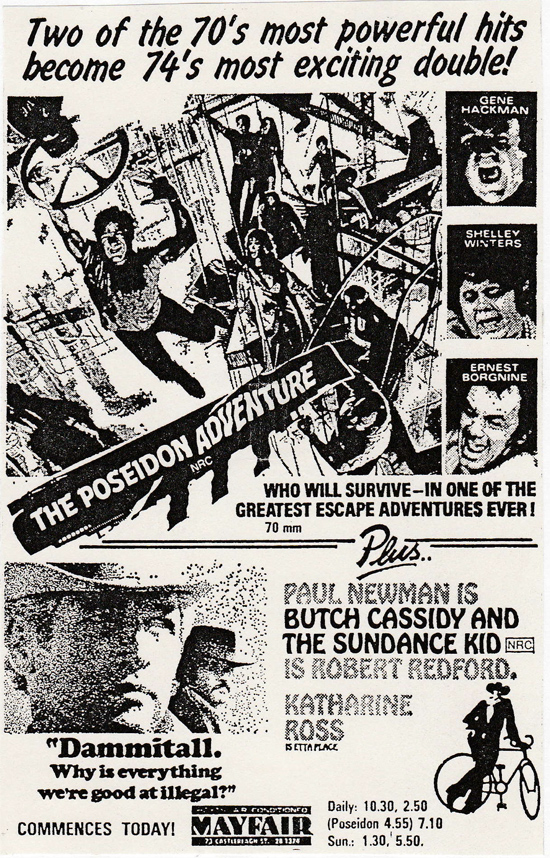 • Village Twin - The
Village Twin Cinemas opened on the 26th December 1970 - the first twin
cinema complex in Queensland. Cinema One [The Blue Room] had a seating
capacity of 555, and Cinema Two [The Purple Room] seated 352. The theatre’s
first 70mm film was Anne of the Thousand Days (which enjoyed a 17-week
season). During the period of the Roadshow Engagement, the Village Twin
presented three 70mm openings which included, Anne of the Thousand Days, The
Wild Bunch and The Three Musketeers. • Village Twin - The
Village Twin Cinemas opened on the 26th December 1970 - the first twin
cinema complex in Queensland. Cinema One [The Blue Room] had a seating
capacity of 555, and Cinema Two [The Purple Room] seated 352. The theatre’s
first 70mm film was Anne of the Thousand Days (which enjoyed a 17-week
season). During the period of the Roadshow Engagement, the Village Twin
presented three 70mm openings which included, Anne of the Thousand Days, The
Wild Bunch and The Three Musketeers. • Avro Bulimba - Importantly and thanks to ex projectionists who confirmed, the Avro was fitted out with modified Kalee 7 projectors, with the operating system in reverse. The mechanical side of the projector became the operating side, with extended drive shafts and 70mm only gates and sprockets manufactured by Cummings and Wilson. Notable 70mm screenings at the Avro Theatre included: The Great Race plus The Miracle of Todd-AO, and the exclusive, “first time in 70mm in Brisbane” screenings of Doctor Zhivago, Zulu and Becket. All three films which had been previously released in 35mm. Canberra • Hobart • Melbourne • Esquire The second theatre in Australia and was equipped with DP70 projectors. For this storyboard we have tried to ascertain which cinema in Perth was the DP70 projectors installed from the Esquire. Below were the projector types installed in six key city theatres in Perth PLAZA / PARIS – DP70 WINDSOR – FH99U ROYAL - VIC 8 PICCADILLY - VIC 8 CINEMA 1 - DP70 CINEMA 2 - DP70 The last 70mm presentation at the Esquire was a move over of The Lion in Winter from the Cinema Centre on the 18th February 1970. The story goes, the projectors were removed from the Esquire around 1975. Replaced with Kalee 21. The Esquire closed in 1976. Cinema 1 Perth opened with Tora!, Tora!, Tora! in 70mm on the 25th February 1971. Cinema 2 Perth opened with Juggernaut in 35mm on the 20th March 1975. The theatres first 70mm presentation was The Three Musketeers. Surviving projectionists have confirmed 70mm spools with Esquire written on them were used at Cinema 1 around 1981 to 1984. Cinema 1 closed in 1990. • Chelsea The sixth theatre equipped for 70mm in Australia with Victoria X projectors. The Greater Union Majestic Melbourne and the Lyric Sydney were refurbished around the same time in the Autumn of 1960. With both cinemas to be equipped for 70mm and a 6-channel stereophonic sound, it was the Majestic which reopened first renamed the Chelsea followed by the Lyric renamed the Forum Cinema. The Majestic Theatre was located at 178 Flinders Street in Melbourne and opened on the 31st August 1912. The theatre was renovated in 1936 with a Gala reopening of The Tunnel on the 24th April 1936. The Majestic closed on the 25th February 1960 for the installation of Cinemeccanica Victoria X dual-gauge 70/35mm projectors and a 6-channel sound system, reopening on the 10th June 1960 as the Chelsea Cinema with the Todd-AO 70mm season of Porgy and Bess. Newcastle Newcastle is located on the east coast of Australia, 159 kilometres north of Sydney. Newcastle is the predominant city of the Hunter Region of New South Wales. The first CinemaScope presentation in Newcastle took place at the Hoyts Civic Theatre and the first 70mm equipped theatre in Newcastle was the Hoyts Royal Theatre. The Royal was also the tenth theatre in Australia to be equipped for 70mm presentation. During the period of the Roadshow Engagement [1958 to 1974], there were three key city theatres in Newcastle fitted out for the 70mm presentation. • Royal The tenth theatre equipped for 70mm in Australia with Victoria X projectors. The Theatre Royal was located at 669 Hunter Street in the city of Newcastle - 160 kilometres north of Sydney. The original Betts Theatre Royal opened under the direction of Edward L. Betts on the 16th June 1924 with Hearts Aflame. It was the Greater J. D. Williams Amusement Co. Ltd. management who had the world premiere of the Australasian Films production of For the Term of His Natural Life at the Royal on the 20th June 1927. In 1938, the Royal was leased to Newcastle Theatres Pty. Ltd. In 1939 the theatre was refurbished and reopened on the 9th March 1939 under the Northern Amusements Corporation Pty. Ltd. banner as the NEW Theatre Royal with the official opening film, Suez starring Tyrone Power. On the 7th August 1942, Hoyts Theatres acquired an interest in Newcastle Theatres Pty. Ltd. and the Theatre Royal’s first film under the Hoyts banner was The Ghost of Frankenstein. The city of Newcastle first CinemaScope was The Robe at the Hoyts Civic on 18th November 1954 and in 1962, the Hoyts Royal became the first cinema outside of a major state capital city to be equipped for 70mm. Fitted out with Cinemeccanica Victoria X projectors [serial numbers 533/599]. |
|
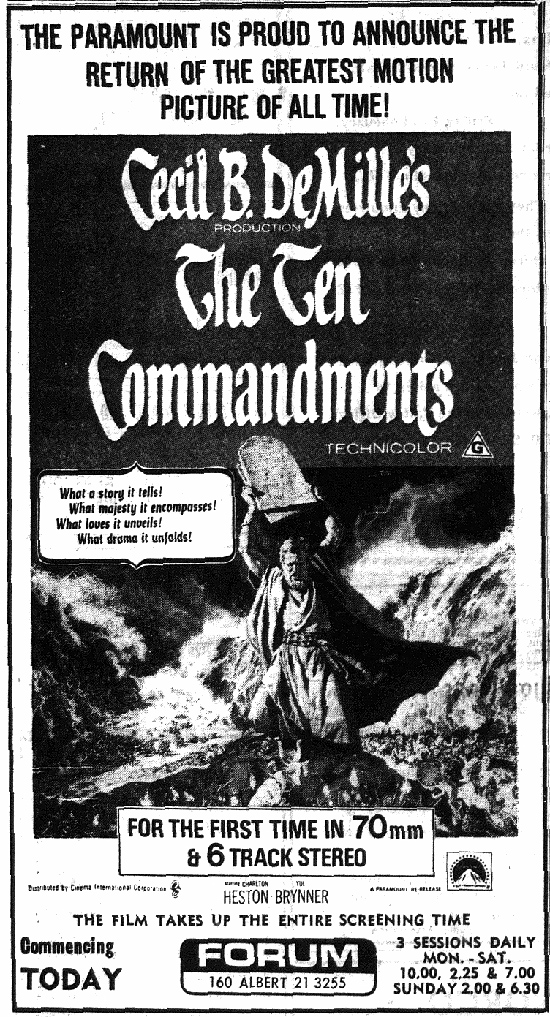 • Royal - In 1962, the Hoyts
Royal became the first cinema outside of a major state capital city to be
equipped for 70mm. Fitted out with Cinemeccanica Victoria X projectors
[serial numbers 533/599] and a six track stereophonic sound system, the
upgrade also required the new screen to be brought forward in front of the
original proscenium. The Todd-AO 70mm screen opening measured 40 feet x 18
feet, with a 128 feet projection throw. The Royal reopened on the 15th March
1962 with Can-Can and during the period of the Roadshow Engagement [1958 to
1974], the Royal became the primary venue for Roadshow presentations in
Newcastle. • Royal - In 1962, the Hoyts
Royal became the first cinema outside of a major state capital city to be
equipped for 70mm. Fitted out with Cinemeccanica Victoria X projectors
[serial numbers 533/599] and a six track stereophonic sound system, the
upgrade also required the new screen to be brought forward in front of the
original proscenium. The Todd-AO 70mm screen opening measured 40 feet x 18
feet, with a 128 feet projection throw. The Royal reopened on the 15th March
1962 with Can-Can and during the period of the Roadshow Engagement [1958 to
1974], the Royal became the primary venue for Roadshow presentations in
Newcastle. • Kensington - The Kensington theatre was located at 299 Hunter Street in the CBD of Newcastle. The Kensington was an independently operated cinema, run by Margaret and Theo Goumas. Established in 1970, the cinema was converted out of a HG Palmers electrical store. A single level auditorium with a depth of 95 feet and seating 418 patrons, the Kensington was designed by architect, Russell Skinner. The cinema was installed with dual 35/70 Victoria 8 projectors. Surviving projectionists recall difficulties in negotiating the access stairs leading up to the projection room. 70mm film trunks were left in the lower foyer storage facilities and spools had to be carried individually to the projection room. The official opening took place on 21st May 1970 with My Fair Lady screening in 70mm. • Strand - The Strand presented White Christmas on the 24th December 1954. As the CinemaScope image at the Strand was smaller in area than that of the VistaVision image, Newcastle Council approved a new screen frame to be built (around 1957) four feet in front of the original proscenium. The new frame supported a wider Cinemascope screen. The alterations included a new, gold main curtain and valance. Then, in 1970, the Strand was equipped with Victoria 8 projectors for the 70mm opening of Airport on the 1st October 1970. Perth • Regional: Sydney Sydney is the capital city of the state of New South Wales and is located on the east coast of Australia. The first CinemaScope presentation in Sydney took place at the Hoyts Regent, followed by 3-strip Cinerama at Hoyts Plaza and 70mm at Hoyts Mayfair. The Mayfair was also the first theatre in Australia to be equipped for the 70mm presentation. During the Roadshow Engagement era [1958 to 1974], there were eleven key city and two suburban theatres in Sydney fitted out for 70mm presentation. These thirteen theatres have been tabled below in date order of their first 70mm presentation. • Mayfair - The theatre’s first film to be screened in CinemaScope was Woman's World – which opened on the 9th December, 1954. The Mayfair closed Wednesday 10th December, 1958 for installation of DP70 projectors and a Westrex 6-Track Magnetic Stereophonic Sound System. It reopened with the premiere of South Pacific and the featurette, The Miracle of Todd-AO [30fps]. The premiere took place on the 24th December, 1958. Many 70mm films followed including: West Side Story, Cleopatra, and The Sound of Music. • Paris + Hoyts Paris, Sci-Fi & Fantasy Festival, 1978 - In 1957 Hoyts refurbished the theatre to present Around the World in 80 Days in a special Michael Todd devised 35mm anamorphic process known - but not advertised - as 'Cinestage'. The film held the record for the longest run of any film screened at the theatre - the 112 week long season opening with a gala premiere on Wednesday, 2nd October, 1957 and ending on the 25th November, 1959. The following day the theatre closed its doors for 11 days – to allow installation of Todd-AO DP70 projectors and a 6-channel stereophonic sound system. The first film to be screened in 70mm at the Paris Theatre was Solomon and Sheba. The longest 70mm season at the Paris was Can-Can, which opened on Saturday, 16th April, 1960 and ran for 82-weeks. • Forum - The Forum opened on the 23rd June 1960. Its first attraction was Porgy and Bess – presented in Todd-AO 70mm. The film closed 24-weeks later; making way for Spartacus (63-week season). The theatre became the venue for the screening of Samuel Bronston historical epics such as El Cid, 55 Days at Peking and The Fall of the Roman Empire. It also enjoyed considerable success with The Great Race and Earthquake; the latter screened in 70mm and Sensurround. • Astra, Parramatta - After the installation of 70mm at the Royal Newcastle in 1962, the Astra Parramatta became the first suburban theatre in Australia equipped for 70mm presentation. The theatre’s first 70mm release was South Pacific, which opened on the 22nd August 1962. Equipped with Cinemeccanica Victoria X projectors, the longest 70mm season during the Roadshow Engagement era was The Sound of Music; opening on the 10th October, 1968 and running for 18 weeks. • Barclay - After Hoyts Theatres relinquished their lease on the Palladium Sydney, the theatre reopened on 23rd December, 1960 as a Greater Union theatre with Battle in Outer Space. With the need for an additional screen capable of the 70mm presentation, the Palladium was refurbished by Greater Union reopening as the Barclay Cinema on the 21st December, 1962 with the CinemaScope feature film, The Guns of Navarone. Its first 70mm film was Barabbas, which opened on the 16th August 1963. |
|
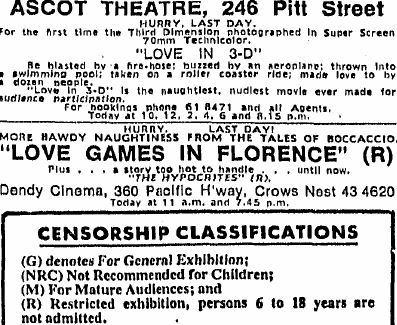 • Plaza - The Plaza presented
numerous event motion pictures, including: Bwana Devil in 3D on the 16th
April 1953; the second CinemaScope release in Sydney - How To Marry a
Millionaire on the 21st January 1954; the Australian premiere season of This
Is Cinerama, which opened in the 3-strip Cinerama format on the 17th
September 1958, and the transition to single lens (essentially 70mm)
Cinerama. The latter process necessitated the installation of 70mm
Cinemeccanica Victoria X projectors for the season of It’s a Mad, Mad, Mad,
Mad World, which commenced on the 3rd December, 1964. • Plaza - The Plaza presented
numerous event motion pictures, including: Bwana Devil in 3D on the 16th
April 1953; the second CinemaScope release in Sydney - How To Marry a
Millionaire on the 21st January 1954; the Australian premiere season of This
Is Cinerama, which opened in the 3-strip Cinerama format on the 17th
September 1958, and the transition to single lens (essentially 70mm)
Cinerama. The latter process necessitated the installation of 70mm
Cinemeccanica Victoria X projectors for the season of It’s a Mad, Mad, Mad,
Mad World, which commenced on the 3rd December, 1964.• Ascot - The Ascot Theatre was located at 246 Pitt Street, in the heart of Sydney's CBD - an address previously occupied by the office of F.J. Palmer (NSW) Pty Ltd. Thomas Virgona, who had operated a number of suburban cinemas, acquired the site and set about planning to build a theatre. The Ascot featured 970 second-hand recovered tip-up seats, along with new Victoria 8 70/35 projectors and 6-channel stereophonic sound. Due to a delay in construction which prevented the cinema from screening My Fair Lady, the Ascot eventually launched with Warner Bros. minor British musical, Wonderful Life, on 12th May, 1966. The Ascot’s first 70mm attraction was Gone with the Wind - which opened on the 25th March, 1967. • Village Cinema City the draft storyboards for 1961 and Village Cinema City Sydney. I was hoping to update these and the 1970 storyboard for next week, which I am now unable to complete with a need for me to be with my family in New Zealand. Both documents are short of completion, my apologies, and I will revisit these in coming weeks when I have further confirmation from our Australian 70mm enthusiasts. • Century - After an amazing 83-week season of Irma La Douce, which ran from on the 12th December, 1963 to the 14th July, 1965, the Century closed and was refurbished throughout and equipped with 70mm Victoria 8 projectors for the premiere of My Fair Lady on the 28th July, 1965. In spite of a slightly reduced seating capacity – down from 920 to 865 – the film went on to chalk up a 96-week run before closing on the 31st May 1967. The season of My Fair Lady was followed by The Bible … in the Beginning - which was presented in 70mm, but not in its intended Dimension-150 format. • Paramount - The Greater Union Paramount Theatre was located at 525 George Street, Sydney and was built on the site of a furniture showroom (E.G. Glass & Coy. in George St.) and an adjoining warehouse to the rear and fronting Kent Street. The cinema stood next to the Victory cinema, which became known as the Rapallo cinema on the 16th December 1966 after an extensive refurbishment. Access to the cinema was via a long lobby, which ran down the northern side of the Rapallo Theatre. It then opened out into a vast single-level auditorium capable of seating 1,140 patrons. The Paramount opened on the 5th May, 1966 with The Spy Who Came in From the Cold. The theatre was equipped by National Theatre Supplies (NTS) with two dual 35/70 Victoria 8 projectors and Cinemeccanica Zenith 450 carbon arcs and one Kalee 21 35mm projector with a GK19 Westrex carbon arc. The first 70mm presentation was the VistaVision reissue of The Ten Commandments on the 23rd November, 1973. |
|
7OMM release Year
|
|
|
• 1958 | 1959
| 1960 | 1961
| 1962 | 1963 |
1964 | 1965 |
1966 | 1967 |
1968 | 1969 |
1970
| 1971 | 1972 |
1973 | 1974 |
|
Sydney in 7OMM (2016) |
|
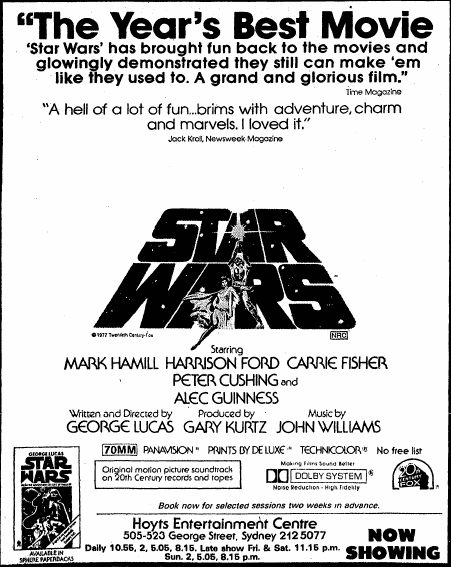 The premise of these eight chapters titled
Todd-AO,
Super Technirama,
Ultra
Panavision,
Super
Panavision, CinemaScope
55, VistaVision, 70mm
Spherical blow up, 70mm
Panavision blow up followed
by four documents on the key city multiplex of Sydney, was to list each 70mm
release, the 70mm equipped cinema and capture the incremental four year
spans for cinema from the opening of
"Around the
World in 80 Days" in 1957 to "That’s Entertainment" in 1974
which for
Sydney, was the end of the Reserved Seating Engagement. The premise of these eight chapters titled
Todd-AO,
Super Technirama,
Ultra
Panavision,
Super
Panavision, CinemaScope
55, VistaVision, 70mm
Spherical blow up, 70mm
Panavision blow up followed
by four documents on the key city multiplex of Sydney, was to list each 70mm
release, the 70mm equipped cinema and capture the incremental four year
spans for cinema from the opening of
"Around the
World in 80 Days" in 1957 to "That’s Entertainment" in 1974
which for
Sydney, was the end of the Reserved Seating Engagement.• Go to In 7OMM with Doug Louden PDF Documents: • Todd-AO in Sydney • Super Technirama 70 in Sydney • Ultra Panavision 70 in Sydney • Super Panavision 70 in Sydney • CinemaScope 55 in Sydney • 7OMM Panavision in Sydney • 70MM Blow-up in Sydney - VistaVision • 70MM Blow-up in Sydney - Spherical • 70MM Blow-up in Sydney - Pitt Centre • 70MM Blow-up in Sydney - Village Cinema City • 70mm Blow Up - Centre on George Street • 70mm Blow Up - Hoyts Entertainment Centre • 70mm Release Summary Sydney • Sydney in 35mm - Part 1 |
|
| Go: back - top -
back issues -
news index Updated 22-01-25 |
